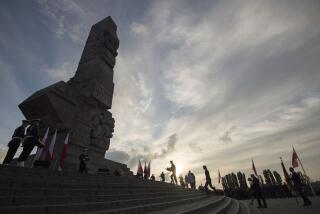Warsaw Cemetery Teaches a Lesson in History
- Share via
WARSAW — It seems a strange place to learn history, Communist-style history, but a military cemetery in Warsaw teaches the complex web of Poland’s past with an unmistakable Soviet slant.
Many monuments dot the Powazki military cemetery commemorating Polish bravery against the Germans in both world wars.
One contains the ashes of Poles who died in concentration camps throughout Europe. Another commemorates those who died fighting Ukrainian Nazis.
But in the area that contains the graves of thousands of young Poles killed in the Russian invasion of 1920--a war that Poland won-- all of the plaques carrying the victims’ names have disappeared over the years.
When new cement crosses were placed at the graves in a renovation program, the names were not returned.
The Polish Communist government wants its citizens to forget that war against its Soviet comrades. Aug. 15, the day the battle began in 1920, was a national holiday until the Communists took over after World War II.
But authorities did not touch the nearby monument to Col. Waclaw Haraszymowicz, who participated in the battle and died in 1923. “One of the first who saw the light of freedom,” says his tomb, referring to the brief years of Polish independence from 1918 to 1939.
Another area contains the graves of several Communist Party officials who were ostracized--some executed--by Stalin but later rehabilitated when Stalin fell from popular grace.
“She died a tragic death fulfilling her job,” is the only explanation on the grave of a woman member of the Polish Communist Party, which was denounced by Stalin as deviating from party doctrine.
Perhaps the most hated example of revisionist history is the monument to Katyn, a small town near the current Polish-Soviet border where 4,000 Polish army officers were slaughtered in 1940.
Based on reports of survivors, the evidence shows the Soviets were responsible for the massacre. The Soviets have never admitted it and blamed it on the Germans. That is also the monument’s story.
“To Polish soldiers, the victims of Nazis, who are buried in the soil of Katyn,” says the stone inscription near a massive granite cross.
Poles know otherwise. Scrawled on the ground nearby in black paint was written, “The KGB did it.”
More to Read
Sign up for Essential California
The most important California stories and recommendations in your inbox every morning.
You may occasionally receive promotional content from the Los Angeles Times.













